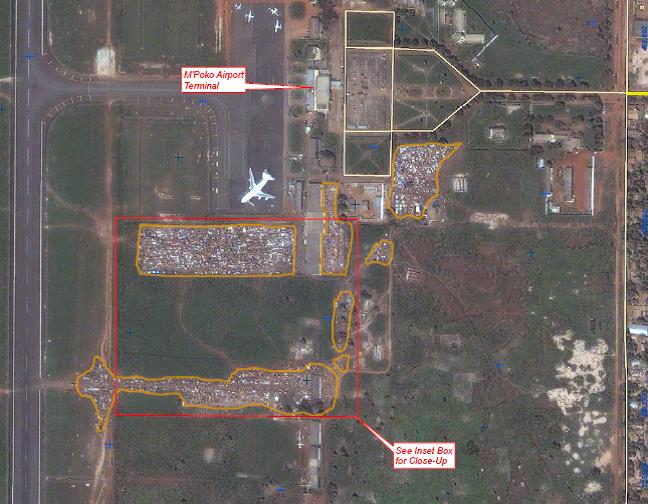17 December 2013, Geneva, Switzerland - As the situation worsens in the Central African Republic, humanitarian organizations are facing a new wave of 214,000 internally displaced persons that will bring the total IDP population to nearly 700,000 according to UN estimates dating this. In addition, over 230,000 refugees who have fled to neighbouring countries to avoid the violence.
The situation, provoked by a conflict that has peaked since the coup in March 2013, is at the centre of the attention of the UN Security Council and of several UN agencies that are mobilising their staff and resources to help the local population in dire need of assistance. A spokesperson for UNHCR said: “in Bangui our staff are reporting continued shooting and a mood of widespread fear”.
Amid the escalating humanitarian effort, UNOSAT has been activated earlier this month to support the locating and monitoring of internal displaced populations affected by the conflict. UNOSAT is providing high resolution imagery analysis of key locations to OCHA, UNHCR, WFP, Medecins Sans Frontieres, the International Committee of the Red Cross (ICRC), and UNICEF. The locations being monitored by UNOSAT experts are of difficult access for humanitarian operators and very unsafe. In such cases remote monitoring using earth observation satellites allows for a close up view of several locations at regular time intervals.
 The first maps have been delivered by UNOSAT starting on 14 December. These analyses show the creation of the first concentration of people trying to escape the violence by erecting informal shelter camps in the vicinity of towns or near Bangui airport. In Bossangoa, Ouham Province for example as of 11 December an area of some 26 hectares in the south part of the town appeared to be a possible IDP location. Another similar but smaller area was detected North-East of Bossangoa. Many IDP seem to have gathered around Bangui’s airport as well. A UNOSAT map released on 17 December shows clearly the presence of newly erected shelter structures. UNOSAT estimates at least 1,600 shelters are visible in the delineated areas in the image although due to poor quality of the satellite image it is likely that this estimate is lower than reality.
The first maps have been delivered by UNOSAT starting on 14 December. These analyses show the creation of the first concentration of people trying to escape the violence by erecting informal shelter camps in the vicinity of towns or near Bangui airport. In Bossangoa, Ouham Province for example as of 11 December an area of some 26 hectares in the south part of the town appeared to be a possible IDP location. Another similar but smaller area was detected North-East of Bossangoa. Many IDP seem to have gathered around Bangui’s airport as well. A UNOSAT map released on 17 December shows clearly the presence of newly erected shelter structures. UNOSAT estimates at least 1,600 shelters are visible in the delineated areas in the image although due to poor quality of the satellite image it is likely that this estimate is lower than reality.
Einar Bjorgo of UNOSAT says: “we confirm large gatherings of IDPs both in the airport area and in other places. We can only estimate population based on the number of shelters observed. In this case there are large fluctuations, with people moving into the camps at night and leaving during the day, also many people stay inside the camps with no shelter at all”.
Image: Detail of UNOSAT analysis over the Bangui airport showing IDP locations. Satellite image by DigitalGlobe.

